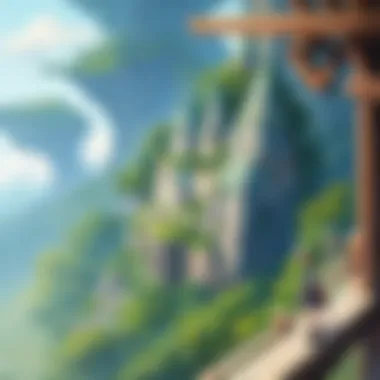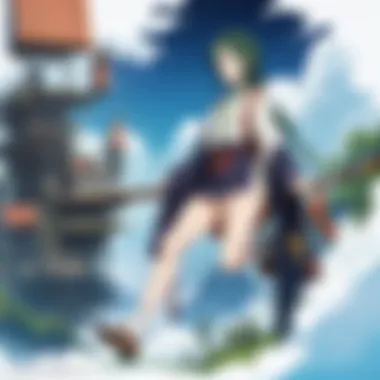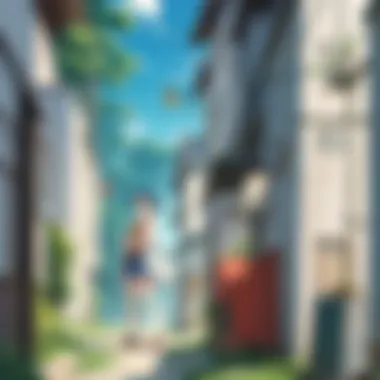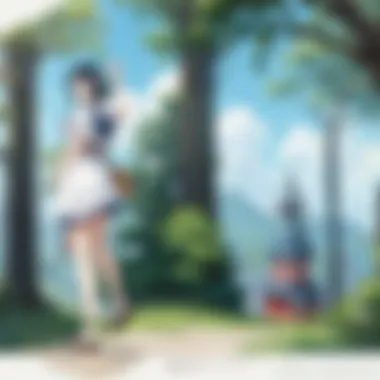A Complete Guide to Studio Ghibli's Iconic Films


Intro
Studio Ghibli has established itself as a powerhouse within the animation industry, creating films that resonate with audiences of all ages. Founded in 1985 by Hayao Miyazaki and Isao Takahata, the studio has transformed storytelling in animation. It is not just the enchanting narratives that captivate viewers, but also the artistry and the emotional depth that their films encompass.
This guide aims to delve into the rich tapestry of Studio Ghibli movies. It will highlight the significance of each film, exploring thematic elements, artistic style, and cultural impact. Furthermore, we will examine how these films have evolved over time, shedding light on character development and their overall contributions to the anime industry.
This comprehensive exploration caters both to casual viewers who admire Ghibli's charm and to dedicated fans seeking an in-depth understanding of what makes these films so remarkable. Let us embark on this journey through the whimsical and often profound world of Studio Ghibli.
Prologue to Studio Ghibli
Studio Ghibli is much more than just an animation studio. It represents a unique approach to storytelling that captivates audiences across generations. In this section, we will delve into the significance of Studio Ghibli, exploring its origins and the key figures who have shaped its vision. This exploration provides a foundation for understanding the distinct qualities that set Ghibli films apart from mainstream animation. By examining these elements, readers will gain insight into Ghibli's impact on cinema and its cultural relevance in today's world.
The Origins of Studio Ghibli
Founded in 1985 by the talented directors Hayao Miyazaki and Isao Takahata, Studio Ghibli emerged from the desire to create animated works that resonate with the heart. The studio was born out of the success of the film "Nausicaä of the Valley of the Wind." This film showcased Miyazaki's exceptional storytelling abilities and artistic vision.
The term "Ghibli" itself refers to a hot desert wind, symbolizing the studio's intent to bring a fresh breeze in the world of animation. The founders aimed to create films that explore complex themes through enchanting storytelling. The first notable work after Ghibli's inception was Laputa: Castle in the Sky, released in 1986. This film set the tone for what would become a legacy of rich narratives and stunning visuals.
Significant Figures Behind Ghibli
The impact of Studio Ghibli cannot be separated from the individuals who have shaped its identity. Hayao Miyazaki is perhaps the most well-known figure, recognized for his ability to weave fantastical elements with real human emotions. His films often reflect a deep connection to nature and a critique of modern society. Alongside him, Isao Takahata brought a different perspective, focusing on themes of family and the human experience in a more grounded style.
Other influential directors include Yoshifumi Kondo, who directed Whisper of the Heart and contributed significantly to Ghibli's visual style, and Hiromasa Yonebayashi, known for works like When Marnie Was There. Each individual brought a unique voice that enriched the tapestry of Ghibli's filmography.
Studio Ghibli has established itself as a beacon of creativity. The exploration of its origins and key figures enriches our understanding of its legacy in animation and cinema.
Overview of Ghibli's Filmography
Studio Ghibli is a milestone in the world of animation. The studio's filmography is not just a collection of movies; it mirrors the evolution of animated storytelling over decades. Understanding Ghibli's films allows viewers to appreciate their artistic styles, unique storytelling, and cultural significance. Each film reveals a facet of Ghibli's approach to animation art, which stands apart from mainstream animation. Moreover, examining Ghibli's filmography aids in recognizing trends and thematic elements that recur and shape the narratives crafted by the studio.
Let's delve deeper into Ghibli's filmography to understand its scope and importance.
How Many Films Are There?
As of now, Studio Ghibli has produced a total of 22 feature films. These films span decades, beginning with Castle in the Sky in 1986 to Earwig and the Witch in 2020. Each film has contributed unique stories and impressive visuals, showcasing the evolution of animation techniques and storytelling methods. Ghibli films are known for their rich narratives and captivating characters, attracting both young and adult audiences.
Studio Ghibli also has a collection of short films and television work, but the primary focus remains on its feature-length animations. Some fans are often surprised that the number of Ghibli films is not larger, given the studio's continued impact on animation. However, quality is cherished over quantity, which reflects Ghibli’s commitment to crafting exceptional stories.
Release Dates and Milestones
Ghibli’s journey is marked by numerous milestones reflecting its growth and influence in animation. The timeline of Ghibli films is filled with critical reception and cultural impact:
- 1986: Castle in the Sky - The first feature film sets the standard for Ghibli's commitment to craftsmanship and storytelling.
- 1997: Princess Mononoke - This film garnered global recognition and placed Ghibli firmly on the world stage, addressing themes of environmentalism and conflict.
- 2001: Spirited Away - This film won the Academy Award for Best Animated Feature and remains one of the highest-grossing anime films, gaining a place in global film history.
- 2004: Howl's Moving Castle - Adapted from Diana Wynne Jones's novel, it continued Ghibli's success, while also exploring complex moral themes.
- 2020: Earwig and the Witch - This was Ghibli's first 3D CGI film, marking a new direction for the beloved studio.
The diversity in styles and themes throughout Ghibli's filmography showcases a mastery of animation that resonates universally.
Understanding these release dates and the significance of each film provides insight into Ghibli’s lasting legacy. The evolution of its stories reflects changes in societal values, artistic techniques, and audience preferences. Ghibli stands as an example of how animation can transcend mere entertainment, provoking thought and emotion.
Key Studio Ghibli Films


The significance of key Studio Ghibli films lies in their ability to blend artistry with deep thematic explorations. They serve as important case studies for both casual viewers and serious critics of animation. Each film brings unique elements to the table, providing insights into Ghibli’s influences, techniques, and ethos.
The selected films in this section are representative of Studio Ghibli's range and impact. They highlight the studio's dedication to storytelling and character development. Studying these films allows viewers to appreciate the growth of animation as an art form, and how Ghibli has continually pushed boundaries.
Spirited Away
Plot Summary
Spirited Away follows the story of Chihiro, a young girl who becomes trapped in a mysterious spirit world. She must navigate various challenges to rescue her parents, who have been transformed into pigs. The narrative’s progression illustrates her growth from a timid child to a brave protagonist. This development is crucial as it reflects universal themes of resilience and courage that resonate with audiences worldwide. Its intricate plot and relatable characters make it a popular choice for those exploring Ghibli’s influence in modern animation.
Themes and Interpretations
The themes in Spirited Away stretch far beyond the initial plot. Issues such as environmentalism, consumerism, and the loss of identity are prevalent throughout the film. These themes create layers of meaning, allowing viewers to interpret the story in various ways. The films ability to tackle serious themes while still being accessible and entertaining is a key strength. This multifaceted approach enhances its appeal to different audiences.
Critical Reception
Spirited Away received acclaim from audiences and critics alike, winning numerous awards including an Academy Award for Best Animated Feature. The film's rich storytelling and beautiful animation set a high standard in the industry. Its reception solidified Studio Ghibli's reputation and established a template for future animated films that sought depth alongside charm.
My Neighbor Totoro
Plot Summary
My Neighbor Totoro tells the story of two girls, Satsuki and Mei, who move to the countryside and discover friendly forest spirits, including the giant creature Totoro. The simplicity of the plot highlights the joys of childhood and imagination. Its narrative encourages a sense of wonder, making it an ideal option for discussions about childhood and its representation in film.
Themes and Interpretations
Themes of family, nature, and childhood run throughout My Neighbor Totoro. The film emphasizes the importance of familial bonds and connection to nature. This carry universal significance, appealing to viewers of all ages. Its ability to evoke nostalgia while engaging with serious themes makes it a standout choice for analysis.
Impact on Popular Culture
The character of Totoro has become an iconic figure in animation, often seen as a representative of Studio Ghibli. This cultural impact extends beyond the film itself, influencing merchandise, fan art, and references in other works. The film's status as a cultural cornerstone highlights Ghibli's far-reaching influence in the animation industry and popular culture.
Princess Mononoke
Plot Summary
Princess Mononoke features Ashitaka, who is caught between the conflict of forest spirits and industrial humans. The story navigates themes of conflict, coexistence, and environmentalism. This deep narrative approach allows for a profound exploration of human nature and the consequences of our choices. The complexity of the plot and characters makes it a vital piece for understanding Studio Ghibli’s narrative depth.
Themes of Nature and Industry
The tension between nature and industry is a key theme. Mononoke champions a message of ecological awareness and balance in a world increasingly dominated by human needs. This duality engages audiences in discussions about sustainability, making the film relevant in today’s context. Its stark visuals coupled with strong messaging adds to its significance in the Ghibli canon.
Artistic Innovations
Princess Mononoke is noted for its mix of traditional and modern animation techniques. The incorporation of detailed landscapes and animated creatures sets a high artistic standard. Its groundbreaking visual style not only captivates viewers but also showcases Ghibli's commitment to pushing artistic boundaries. Such innovations have laid the groundwork for many contemporary animated projects.
Howl's Moving Castle
Plot Summary
Howl's Moving Castle revolves around Sophie, a young woman cursed to become an old lady. She seeks refuge in Howl's magical moving castle, where she discovers not only magic but also love and self-acceptance. The intertwining of personal growth and fantasy elements makes this film a compelling exploration of transformation.


Symbolism and Motifs
The film is rich in symbolism, particularly surrounding themes of war and humanity. Howl represents the struggle against both internal and external conflicts. The symbols used throughout the movie enrich the narrative, providing deeper insights into characters and their motivations. This complexity is vital for viewers analyzing Ghibli's thematic practices.
Reception and Legacy
Howl's Moving Castle received widespread praise for its animation and storytelling. It was nominated for an Academy Award, further cementing Ghibli’s status in the film industry. Its legacy includes inspiring countless animators and filmmakers who aspire to create visually stunning stories. The impact of this film contributes to the lasting influence of Studio Ghibli in global cinema.
Nausicaä of the Valley of the Wind
Plot Summary
Nausicaä follows the titular warrior princess as she strives to find balance between humanity and nature in a post-apocalyptic world. The narrative reflects important issues such as peace, survival, and environmental responsibility. Its engaging plot and unique settings make it a pivotal work for discussions about Ghibli’s narrative themes.
Environmental Themes
Environmental concerns are central to Nausicaä's storyline. The film raises awareness about ecological issues, a theme that resonates with modern audiences. Its portrayal of struggle against environmental degradation shows relevance to current societal challenges. This focus on the natural world enhances the film's significance within Ghibli's body of work.
Influence on Future Works
Nausicaä's impact can be seen in numerous films that followed. Its blending of strong female characters with ecological themes has inspired future creators. The storytelling techniques and thematic depth set a precedent that many animators gauge their work against. This influence establishes Nausicaä as not just a film, but a cornerstone in animated storytelling.
Ghibli's Collaborations and Co-Productions
Studio Ghibli's success is not just due to its internal talents but also to strategic collaborations and co-productions that have expanded its reach and influence in the animation world. These partnerships have brought together various artistic visions and cultural perspectives, enhancing the narrative depth and aesthetic of Ghibli films. In this section, we will explore notable partnerships and the impact of these collaborations.
Notable Partnerships
Studio Ghibli has worked with multiple international companies, sharing its expertise and artistic style. These collaborations often involve different studios and filmmakers, contributing to a cross-cultural exchange of ideas and techniques. Some significant partnerships include:
- Disney: Disney's involvement in distributing Ghibli films outside Japan began in the 1990s. This partnership introduced a wider audience to films like Spirited Away, ultimately leading to its Academy Award win for Best Animated Feature.
- Ghibli Museum: Established in 2001 in Mitaka, Japan, the Ghibli Museum is a collaboration between the studio and various artists. It showcases Ghibli's films while preserving the essence of the studio's imaginative narratives. The museum continually exhibits new works, enhancing cultural appreciation.
- TV and Video Game Collaborations: There have been instances where Ghibli's art styles influenced video game development, such as the collaboration with Level-5 for the Ni no Kuni series. The game's art style resonates with the enchanting visuals of Ghibli films, promoting a deeper understanding of storytelling in different mediums.
These partnerships illustrate how Ghibli has maintained a balance between staying true to its roots while embracing external influences. The collaborations have enabled Ghibli to reach a global audience, allowing for a blend of distinct styles and languages.
Impact of Collaborations
The influence of collaborations can be seen not only in the aesthetic quality of Ghibli's films but also in the narratives they present. Working with various stakeholders has led to:
- Enhanced Creative Expression: By combining ideas with international creators, Ghibli films often become richer in content. Fusion of different storytelling styles creates unique experiences for audiences.
- Cultural Exchange: Each collaboration brings a new cultural perspective. For example, partnerships with foreign distributors lead to adapted marketing strategies aimed at resonating with local audiences.
- Stronger Industry Presence: These collaborations have solidified Ghibli’s status within the animation industry. By partnering with established names, Ghibli continues to push the boundaries of animation and storytelling, setting new standards.
The importance of Ghibli’s collaborations extends beyond mere artistic enhancement. They have been crucial in keeping the studio relevant in an ever-evolving industry. Through these collaborative efforts, Studio Ghibli not only preserves its legacy but also paves the way for future innovations in animation.
Thematic Analysis of Ghibli Films
The exploration of themes in Studio Ghibli films is vital to understanding the studio’s impact on animation and storytelling. Thematically rich narratives resonate deeply with audiences, spanning generations. Ghibli films often feature complex character relationships, moral dilemmas, and the interconnectedness of humanity with nature. A thematic analysis reveals who these films appeal to and explains their continued relevance in a changing world.
Common Themes
Nature and Environment


Nature and environment play a crucial role in Ghibli films. The studio often portrays nature as a living entity, reflecting its beauty and fragility. This theme fosters a connection between characters and the world they inhabit, emphasizing the importance of environmental preservation. For example, films like "Princess Mononoke" illustrate the struggle between industrialization and nature through vivid depictions of forests and creatures. This portrayal attracts viewers who appreciate environmental issues, making it a worthwhile focus for discussion in the article. The unique feature here is Ghibli's ability to blend fantasy with ecological messages, encouraging audiences to reflect on their relationship with the environment.
Childhood and Growth
Childhood and growth are recurring elements in Ghibli films, often depicted through a child's eyes. This theme explores themes of innocence, discovery, and transformation. Films like "My Neighbor Totoro" and "Spirited Away" showcase the transition from childhood to maturity, prompting viewers to reflect on their own experiences of growth. This choice resonates with a wide audience, making it a beneficial aspect to include in the article. The unique feature of this theme is its ability to resonate across demographics, invoking nostalgia and reflection on one’s life journey. It also opens discussions about the challenges and beauty of growing up.
War and Peace
The themes of war and peace in Ghibli films provide a thought-provoking commentary on human conflict. Ghibli does not shy away from depicting the harsh realities of war as seen in "Grave of the Fireflies" or the surrealist touches in "Howl’s Moving Castle." These films often portray the impact of war on individuals and communities, emphasizing the need for peace and understanding. This is a popular and pressing topic that appeals to audiences grappling with contemporary issues. The unique advantage here is its ability to stimulate discussions around social justice and human kindness, making it relevant to a politically aware audience.
Character Archetypes
Strong Female Characters
Strong female characters are a hallmark of Ghibli films. Protagonists like Chihiro from "Spirited Away" and San from "Princess Mononoke" exemplify independence and resilience. Their journeys often challenge traditional gender roles, presenting women as complex, capable beings. This theme contributes significantly to the overall narrative richness of Ghibli’s work. It’s a beneficial inclusion in the article because it addresses gender issues while showcasing diverse representations in animation. The unique aspect is the depth given to these characters, often depicting their growth through personal challenges. This strengthens the narrative and makes it more engaging for viewers.
Nature Spirits and Deities
Nature spirits and deities frequently inhabit Ghibli's universe, enriching the narrative landscape. Films like "Spirited Away" and "My Neighbor Totoro" introduce beings that represent various elements of the natural world. These characters often serve as guides or catalysts for human growth, blending the spiritual with the everyday. This choice adds a layer of mysticism that appeals to audiences interested in folklore and spirituality. The advantages include the ability to communicate deeper messages about respect for nature and harmony. However, it may also present challenges for viewers less familiar with such archetypes, potentially limiting their understanding.
"Studio Ghibli films illuminate themes that resonate, inviting viewers to engage in deep reflection. This thematic depth is what distinguishes them in the world of animation."
The Future of Studio Ghibli
Studio Ghibli stands at a pivotal point in its history. With a legacy that has reshaped animation, the studio must navigate the tension between honoring its past and embracing innovation. This section aims to explore the future of Studio Ghibli, focusing on how its upcoming projects and continued influence on animation shape its path forward. Speculations and predictions dominate discussions among fans and critics alike, making this an essential topic for anyone interested in the evolution of anime and filmmaking.
Upcoming Projects
As Studio Ghibli moves forward, several exciting projects have been announced or are under consideration. Hayao Miyazaki, despite his previous assertions of retirement, is working on a new film titled How Do You Live? This project marks his first feature-length film since The Wind Rises, and it generates significant excitement within the animation community. Details on the plot remain scarce, but the film reportedly aims to adapt a classic novel by Yoshino Genzaburo, thus continuing Ghibli's tradition of literary adaptations.
In addition to Miyazaki's efforts, Studio Ghibli has also announced an animated adaptation of the beloved children's book Earwig and the Witch, which directed by Goro Miyazaki. This project is notable as it embraces 3D CGI animation—a departure from Ghibli's traditional 2D style, possibly indicating Ghibli's willingness to explore new techniques while maintaining its artistic integrity.
Overall, the upcoming projects show a blend of new stories and familiar themes, catering to existing fans while drawing in new audiences. The mix of traditional and groundbreaking styles demonstrates Studio Ghibli's commitment to evolving without losing its core identity.
Continued Legacy in Animation
Studio Ghibli's influence in animation extends beyond its films. The studio's approach to storytelling, artistic detail, and character development set a standard that many animators and filmmakers aim to achieve. Ghibli’s films often reflect deep emotional truths, prioritizing character depth and thematic richness which resonate with viewers of all ages.
As animation continues to flourish globally, Ghibli's methods inspire a new generation of filmmakers, not just in Japan but around the world. For example, modern animated films such as Coco and Inside Out draw from the thematic exploration finely honed by Ghibli. Furthermore, there is evidence of Ghibli's practices manifesting in various styles, from Western animation studios to independent creators who wish to convey more profound messages through their art.
"Studio Ghibli has established itself as a benchmark for quality in storytelling and artistry in animation, and its future projects promise to keep this legacy alive."
In summary, while the studio prepares for new releases, its legacy continues to shape the landscape of animated storytelling. The commitment to authenticity, artistry, and emotional depth in its projects ensures that future endeavors will uphold the studio's renowned reputation. Studio Ghibli will no doubt continue to influence animation's future as it explores new narratives and technologies.
Finale
The conclusion serves as a significant endpoint in understanding the full breadth of Studio Ghibli's contributions to animation and world cinema. It synthesizes the myriad elements discussed throughout the article, providing readers a frame to reflect on the importance of these cinematic works. Ghibli's films resonate across cultural boundaries, embedding themselves into the fabric of global animation through their unique storytelling and artistic expression.
Reflection on Ghibli's Impact
Studio Ghibli has not only elevated the anime genre but has also deepened the appreciation for animated storytelling at large. The studio's ability to weave complex narratives around universal themes has set a benchmark for quality in animation. Characters crafted by Hayao Miyazaki and Isao Takahata are not merely animated entities; they represent nuanced explorations of humanity, nature, and culture. Films such as "Spirited Away" and "Princess Mononoke" have educated audiences on environmental consciousness and the intricacies of human relationships. This impact underscores how Ghibli's artistry transcends age and background, making their films relevant and accessible to a diverse global audience.
The artistry of Studio Ghibli resonates and influences new generations of filmmakers and animators, promoting a legacy that prioritizes imagination and ethical considerations.
Final Thoughts
In summation, the legacy of Studio Ghibli is intertwined with the evolution of animation as a serious and impactful art form. As the studio continues to create new stories and explore ongoing narratives, both fans and newcomers stand to gain profound insights from their work. Each film invites viewers to confront personal themes, reflect on societal issues, and appreciate the wonders of creativity. Studio Ghibli will undoubtedly remain a cornerstone of animation for years to come, shaping how stories are told and experienced in the medium.



